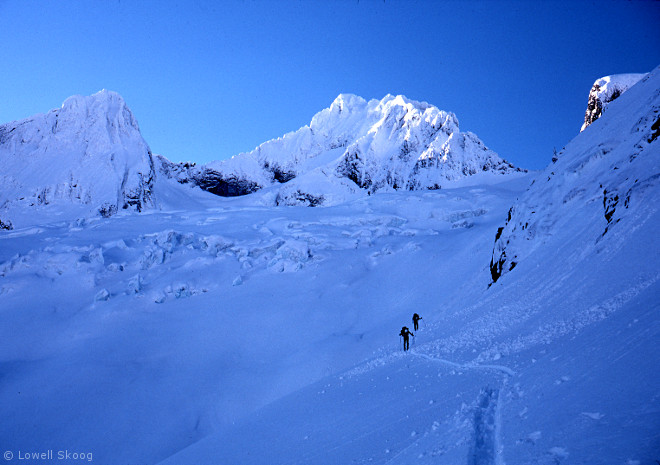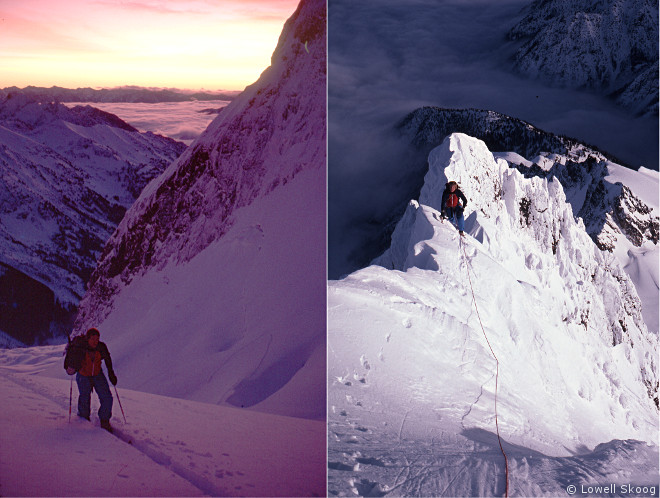
In 1977, The Mountaineers published Volume 2 of Fred Beckey's encylopedic Cascade Alpine Guide. This volume covered the Cascade Mountains from Stevens Pass to Rainy Pass, including the highest non-volcanic summit in the range, Bonanza Peak. After graduating from college in December 1978, I landed an engineering job and began a routine of weekend outings—skiing in winter and spring—climbing in summer and fall. I acquired ski mountaineering gear (Ramer bindings, short K2 skis, strap-on climbing skins) and began thinking of ways to combine skiing with climbing. Beckey's guidebook seemed to indicate that Bonanza Peak had never been climbed in winter, so Gordy, Mark and I set our sights on the peak for the Christmas holidays of 1979.
The day after Christmas, Gordy, Mark and I left Seattle at 4:30 a.m. to catch the Lady of the Lake from Chelan to Lucerne, about 40 miles by boat up Lake Chelan. Thanks to a light early-season snowpack, the bus was still running from Lucerne to Holden, and we were greeted by the people at Holden (a Lutheran church community) who seemed quite interested in our project. A little after 2 p.m., we began skiing toward mile-high Holden Lake, breaking trail through several inches of fresh snow. We reached the lake in moonlight four hours later, at the end of a short winter's day. My photos from the trip show the three of us camping in bivi sacks under a rainfly supported by our skis. Apparently we didn't bring an actual tent.
On the 27th, we awoke to a beautiful, clear dawn. In mid-morning we climbed to Holden Pass, about 1100ft above the lake, and began traversing southeast-facing slopes toward Mary Green Glacier. Due to the short winter day, we were soon in the shadow of Bonanza's long southeast ridge. We climbed to around 8000ft near the north edge of the glacier and began digging a snow hole. It took an hour or two to dig a cave large enough for three to lay comfortably. When we were finished, I skied without a pack toward the summit pyramid of Bonanza to break trail for the next day. The night was clear and cold, with gusty winds. Moonlight illuminated the glacier and surrounding peaks, thoroughly plastered by snow.
On the third day, we left the cave before dawn, skiing up the glacier as sunrise colored the surrounding peaks in hues of violet, pink and gold. We skied to the highest point of the glacier and noticed signs of high clouds already moving our way. We exchanged our skis for crampons, and by 8 a.m. were kicking steps, unroped, up the east face of Bonanza's summit pyramid. The snow climbing was straightforward, and after reaching the summit shoulder, we pulled out our rope and I led a class-4ish pitch without much protection over ice-encrusted rocks to the top.
From the summit, we gazed upon a cloud sea, brilliant in the morning sun, with the high ridges and peaks of the North Cascades rising like snowy continents. Our view spanned the Cascades from Mt Rainier, in southern Washington, to Mt Redoubt, next to the Canadian border. High clouds told us the weather would soon be changing. We made a single long rappel down an icy gully from the summit, stowed the rope, and began backing down the steps we'd kicked on our ascent. Gordy carried a small movie camera, and he had been shooting film during our ski ascent and summit climb. At some point during the descent, the camera, stowed inside his wind jacket, disappeared. Gordy was distraught, but we couldn't afford to be distracted and had to focus on the climbing at hand. We later found film from of the camera during our descent. I no longer remember if the film was ever developed. It must have been spoiled during the camera's tumble down the mountain. Descent on skis to the snow cave went quickly.
Around 2:30pm, after collecting our overnight gear, we left the snow cave and skied difficult, wind-packed snow back to Holden Pass. It was cloudy now, and though the snow lower on the mountain was somewhat better, it was still a workout, skiing in climbing boots with full packs, to descend to Holden Lake. Little snow fell that night, and late in the morning of the fourth day, we skied up the southwest slopes of Martin Peak to the point where they steepened. Clouds blocked the view of Bonanza Peak, but we enjoyed excellent skiing down mostly open slopes back to the lake. In mid-afternoon we skied back down the trail to Holden, negotiating some of the switchbacks at break-neck speed. We pitched camp next to the Holden baseball field then visited the town. We were welcomed to eat cookies, read magazines, and play pool and ping-pong with the Lutherans. We arranged transport to Lucerne the next day and returned to Chelan by 6pm on our fifth day out.
Epilogue: On March 20, 1993, Mark Bebie and two friends died while
attempting Slipstream on Snow Dome in the Canadian Rockies. Over the
span of a decade, I did 55 trips with Mark, probably a greater number of
technical ascents than with any other partner. After Mark quit his job at
Microsoft in 1988, he went on a tear of difficult ascents, and I didn't climb
with him again. His obituary published by the American Alpine Club can be
viewed
here.
—Lowell Skoog, May 2023
|
The Alpenglow Gallery





